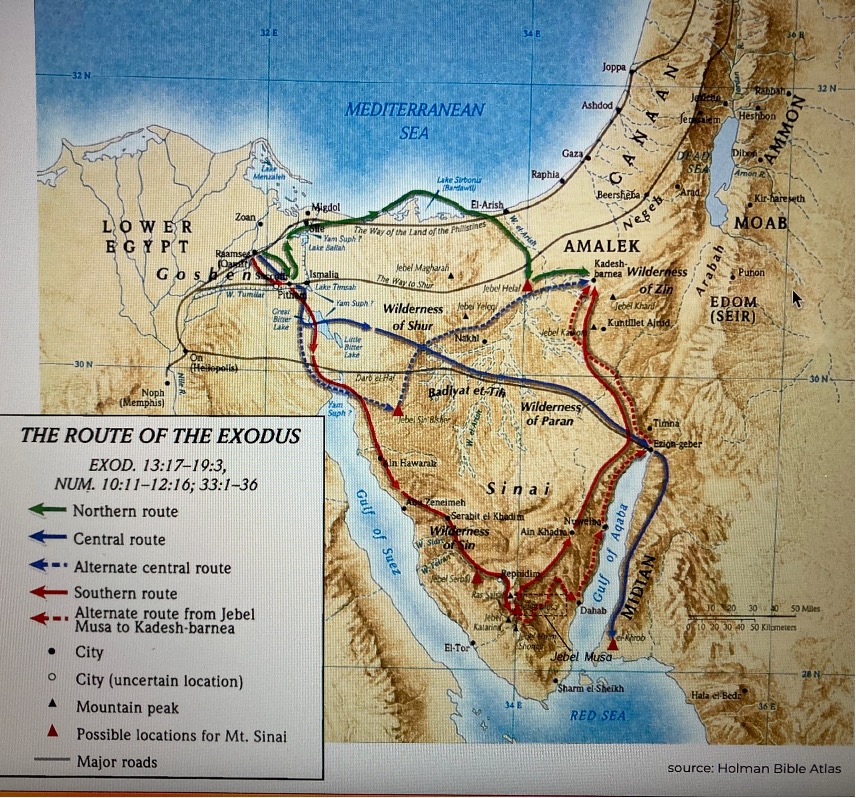Prayer Fuel
THE MOUNTAIN
To this day not everyone agrees on where Mount Sinai is.
Below is a summary of the most popular theories.

- The Direct Northern Route
Some textual scholars discount the detour into South Sinai and think the Israelites travelled straight from the Reed Sea to Kadesh Barnea. They therefore looked for high points in the North and found Mount Sin Bishar, Mount Helal, Hashem el-Tarif, Petra, and Mount Hermon.
2. A Volcano
Some naturalist 20th-century scholars perceived the cloud, smoke, fire and thunder described in Exodus 19 to be a volcano. They then looked for possible volcanoes within the region and found Jebel Baggir / Jebal al-Noor (mountain of light) at the Northern end of the Gulf of Aqaba.
3. Arabia
The current most popular view on YouTube is that Mount Sinai is Jebel al-Lawz, in Western Saudi Arabia. This view has been around since the 1980s. Ron Wyatt found ‘evidence’ such as drawings of bulls on the rocks around Jebel Laws and a large split rock he thought was the rock from which Moses brought water.
Bob Cornuke, a former Los Angeles SWAT policeman and estate agent, then popularised the case that the Israelites crossed the Gulf of Aqaba from Neweiba to Median Saudi Arabia. He claims to have found the remains of coral-infested chariot wheels at this site. Cornuke also ‘discovered’ anchors from Paul’s shipwreck off Malta and the fossilised remains of Noah’s ark in Iran. His ‘discoveries’ were promoted through books, YouTube, Fox News, CNN, and Good Morning America.[1]
The most interesting part of the thesis is that Moses’s father-in-law Jethro was from Midian in Western Saudi Arabia. Even today some of the Sinai Bedouin on the east coast have close relationships with the Bedouin tribes in Western Saudi Arabia.
A major problem however is to reach the Gulf of Aqaba from Goshen takes a whole day bus journey on paved roads. Transporting children, the elderly, livestock and processions on foot across such distances so quickly while being perused by an elite national army is problematic.
The argument mentions that Paul refers to Mount Sinai in Arabia,[2] and that Paul visited Arabia for three years.[3] However, Arabia in the first century was not only the Arabian Peninsula but included the Sinai and the Syro-Arabian desert within modern-day Syria and Jordan.
4. The Highest Peak in South Sinai
In his book The Antiquities of the Jews, the historian Flavius Josephus stated that Mount Sinai was ‘’the highest of all mountains thereabouts.’’[4] Mount Catherine (2,629m) is the highest peak in the collection of peaks known as Mount Sinai or the Holy Mountains, South Sinai. Jebal Mousa (2,285m), is within this vicinity.
5. The Traditional View – Jebel Musa, South Sinai
Since the early Christian era monasticism in South Sinai was an escape from Roman persecution. In the fourth century, monks established places of worship around Jebel Mousa. In 330 CE Empress Helena, the mother of Constantine I, built a church there to protect monks from raiding nomads.
In 527 to 563 the Byzantine Emperor Justinian I established Saint Catherine’s Monastery at the foot of Jebel Musa where the burning bush was believed to be located. St. Catherine Monastery is the oldest continually functioning monastery and library in the world. For centuries it kept the Sinaiticus fourth-century copy of Scriptures containing the entire New Testament with about half the Old Testament.
The Monks claim that in 628 CE the Prophet Muhammed sealed a Covenant of Protection for the Monastery with his own hand. This document guarantees freedom of movement and worship and other privileges to the followers of Jesus the Nazarene at St. Catherine.
Currently, the tour guides, the local Bedouin, Jews, Muslims and devout, particularly Orthodox, Christians consider Jebal Mousa to be Mount Sinai.
The one clear thing is that Mount Sinai represents a time and place where heaven and earth met. The LORD encountered and spoke to Moses and the children of Israel causing them to become a unique nation shaped by His acts, promises and laws from heaven.
Prayer
Take time to tell the Lord how much you love him.
Take time to quieten yourself, let go all the business of the day and acknowledge that you desire above all else that you desire to hear and obey his still quiet voice.
We pray with thanksgiving for the pilgrims and tourists who visit St. Catherine’s and Jebal Mousa each day. May they be reminded of your presence and good purposes for their lives. May they hear your still small voice speaking to them. May those without faith be quickened. May those battered and wearied from life find rest. May those without meaning and purpose find hope. May those who are searching for a mission in life find inspiration and courage to play their part in bringing your liberating Kingdom wherever you have so wisely placed them.
[1] https://en.wikipedia.org/wiki/Bob_Cornuke
[2] Galatians 4:25.
[3] Galatians 1:17.
[4] https://penelope.uchicago.edu/josephus/ant-3.html Chapter 5, paragraph 1.
